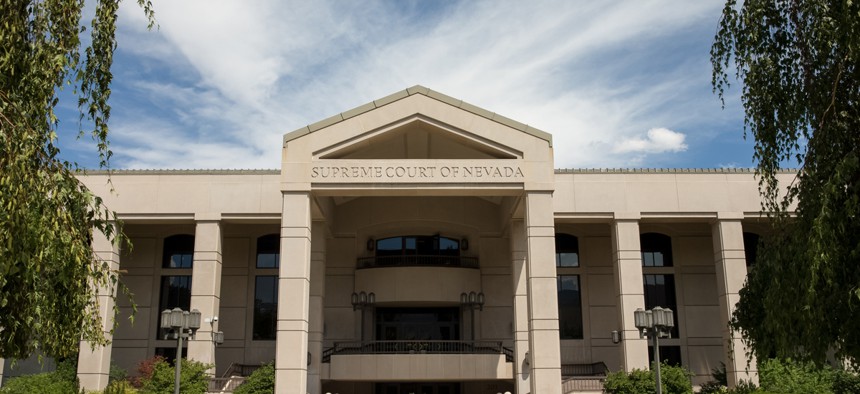The Problem With Funding Government Through Fines

James.Pintar/Shutterstock.com
A budget shortfall at the Nevada Supreme Court underlines a broader fiscal quandary
Last week, Jim Hardesty, the chief justice of the Nevada Supreme Court, warned that the state’s highest court was almost out of money. “If this is not addressed by May 1, the court will not have sufficient cash to operate,” Hardesty told lawmakers at a committee hearing last week. “I believe the legislature has a constitutional obligation to fund the judicial branch of government. Do you want me to close the judicial branch of government at the state level on May 1?”
Many states, including Nevada, have faced budget shortfalls since the Great Recession began. But this one isn’t caused by a decline in tax revenue, but by a decline in traffic tickets, which provide the majority of funding to the state supreme court. “Now with all due respect to the citizens of Nevada, I don’t think anyone is driving better,” Hardesty told legislators. “I think the truth is we’re seeing less traffic violations because law enforcement’s priorities have changed and it has changed dramatically.”
According to the Las Vegas Review-Journal, the state highway patrol shifted its focus towards more dangerous violations instead of trivial ones. As a result, the number of tickets issued declined by over 10 percent over the last two years. The Nevada legislature, which only sits part-time, drafts its budgets in two-year blocks. When their projected revenue estimates don’t match what the state collects in that two-year span, shortfalls occur. The state supreme court nowfaces two of them: first, a $700,000 gap in its current budget that will leave the court broke on May Day, and second, a $1.4 million shortfall in its next biennial budget.
Nevada isn’t the only state where ticketing enforcement is in the headlines. A blockbuster Department of Justice report released last month found that the Missouri municipality funded itself by harassing and fining its residents for trivial offenses. Statistics from nearby municipalities suggest the problem isn’t limited to Ferguson, and may even be worse elsewhere in Missouri. If Ferguson illustrated the pitfalls of turning law enforcement into a collection agency, then Nevada shows the bind facing states as they try to extricate themselves from relying on tickets and fines for revenue.
When it comes to seeking revenue, Nevada has long opted for the lightest possible touch. The state doesn’t collect personal or corporate income tax, a capital gains tax, or an estate tax, for example. This laissez-faire approach often attracts corporate refugees from high-tax states. Apple, Inc., which is headquartered in California, opened a subsidiary in Reno in 2006 that allowed it to circumvent almost all taxes on its investments, according to a New York Times report. Unlike California, Nevada taxes neither corporate income nor capital gains, so Apple’s move essentially deprived both states of potential revenue.
These fiscal woes are almost as old as the state itself. It entered the Union amid the Civil War and a silver rush that promised rapid population growth. But soon the mines ran out, and the boomtowns gave way to ghost towns. As Nevada’s economy spiraled downward, its tax base evaporated. The state’s population dwindled to just over 42,000 residents by 1900; nearby San Francisco had over 340,000 residents that same year. The New York Times worried that other sparsely populated Western territories would repeat the “blunder” of Nevada, which it called “a dying state” in 1889. Thought leaders of the era also proposed mergers with California, Utah, and Arizona. “The silver mines which made her all she was have been exhausted,” theChicago Tribune concurred in 1896. “She has no other mineral wealth. She has no agricultural resources. She has nothing to attract people, and as a consequence she is flickering out.”
Nevada set about attracting people by allowing them to do what they could not do elsewhere. The state legalized gambling, liberalized its divorce laws, and reoriented its economy toward tourism. By the mid-20th century, the casinos had displaced mining as Nevada’s economic engine. Many Nevadans of the time saw gambling not as a vice to be quashed, but a salvation from the boom-and-bust cycles that had determined their livelihoods. Edward F. Sherman captured this mindset in an October 1966 article for The Atlantic Monthly, in which he assessed the outsized impact of casinos on the state economy:
When Nevadans realized after World War II that gambling had exceeded their wildest dreams of bringing tourists and dollars into the state, all resistance to the gambling establishment ceased. Impressed by the seemingly endless flow of silver dollars, they convinced themselves that they lived in a never-never land where gambling taxes could support the state without the need for income, estate, gift, or corporation taxes. The truth was that gambling taxes did not produce enough revenue, and that only Nevada's failure to provide even the basic social services permitted such low taxation.
Although many Nevadans still like to think of their state as a unique gambling principality like Monaco, the fact is that it is a vast, diverse area of 110,000 square miles, the seventh largest state in the union, with a population that is exploding at a rate of more than 5000 a month…As more and more people come streaming into the state, the need for social services—for schools, universities, urban planning, water, welfare programs, and regulation of vested interests—becomes acute. But the unbalanced state economy, in which gambling still provides a quarter of the tax revenues and generates half of the economic activity, does not furnish a viable base from which to finance social services. Nevada is faced with the strong need to attract new industry in order to diversify its economic structure.
To escape this new fiscal quandary, Nevada went to great lengths to diversify its economy and tax base. This effort has yielded some results: Mining and gambling now account for about 25 percent of the state’s overall revenue. Just as it once wrote its laws to help people escape their states’ moral strictures, Nevada crafted its tax code to help business and industry evade taxes elsewhere. Its greatest triumph came last year when Governor Brian Sandoval announced that the state outbid Texas, California, and Arizona for Tesla Motors’ new “gigafactory” complex. Tesla CEO Elon Musk had said that prospective states would need at least $500 million in tax breaks to lure the electric-car company there. In the ensuing race to the bottom, Nevada’s legislature responded by granting Tesla $1.25 billion in tax breaks—more than double what Musk sought—over the next 20 years.
This is no small victory for the state. The new facility, which will build the lithium-ion batteries for Tesla’s electric-car fleet, will be one of the largest business investment projects in the country. According to the Reno Gazette-Journal’s breakdown of the Tesla deal, the gigafactory is expected to create 6,500 direct jobs and roughly 22,000 indirect jobs, equivalent to roughly 11 percent of northern Nevada’s workforce. It’s a desperately needed economic boost to the state hit hardest by the Great Recession, which still struggles with the highest state unemployment rate and an anemic housing market. Compared to its potential $100 billion economic footprint by some estimates, the $1.25 billion tax break makes sense. But if Tesla actually paid that much in taxes, instead of receiving it as an inducement to relocate, it could also fund the Nevada Supreme Court at its current requested levels for the next 106 years.
The challenges that tickets and fines bring aren’t limited to Nevada or Ferguson. In January, a brief NYPD work slowdown cost New York City $5 million in expected revenue, according to The New York Times. Although Hardesty didn’t invoke New York’s experience, he highlighted a similar paradox that the justices face. “The court encourages the commission of crime so that we have adequate money to operate,” he told legislators. Hardesty floated the idea of funding the entire court through the state’s general fund. Whether state legislators will take this step is unclear. Even when the ethical and fiscal problems with financing government through fines are apparent, viable alternatives remain hard to find.
(Image via James.Pintar/Shutterstock.com)






